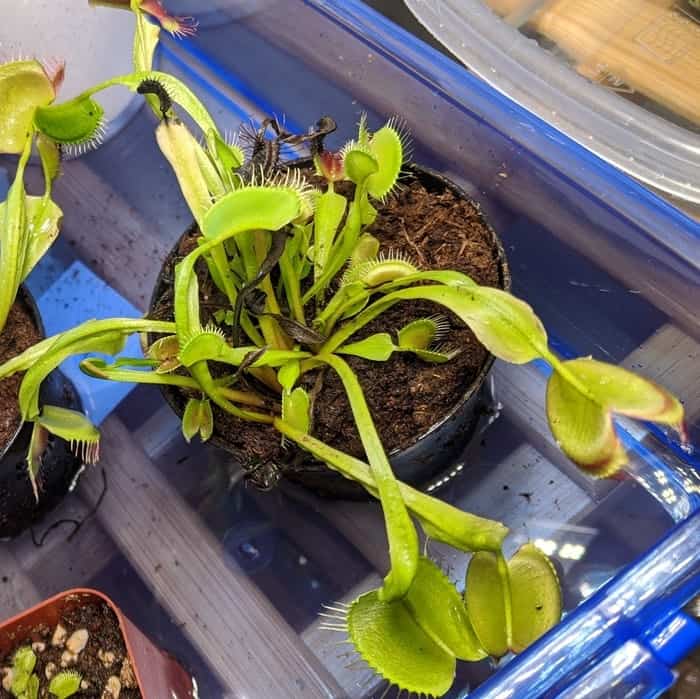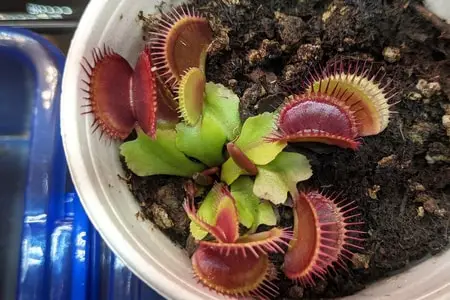Venus flytraps have precise requirements to stay alive. One of the major needs for Venus flytraps is adequate lighting. And with lighting, you have several options: artificial lighting, direct sunlight, and indirect sunlight.
As a general rule, Venus flytraps should grow under direct sunlight for at least 6 hours a day to remain healthy and optimally receive more than 10 hours of direct sunlight. Venus flytraps can also grow with artificial lighting, but the light specifications must be suitable for carnivorous plants.
In this article, you will learn all the details and tips to provide an optimal amount of light for your Venus flytraps.
Venus Flytraps and Direct Sunlight
Venus flytraps can grow in a spot where they receive direct sunlight for a few hours and then indirect sunlight for the rest of the day.
Six hours of direct sunlight is the minimum recommended for Venus flytraps. Venus flytraps can survive under bright indirect sunlight as long as they receive a combination of direct and indirect sunlight with at least 4-6 hours of direct sunlight.
Providing a minimum of six hours can be appropriate, but I would not recommend aiming for the minimum.
Venus flytraps grow faster and look much healthier when they are grown under more sunlight. Optimally, Venus flytraps should receive over 10-12 hours of sunlight.
Can Venus flytraps get too much sun?
Venus flytraps can’t receive too much sun. Extensive light exposure will only stimulate growth and strengthen the plant. Providing 12+ hours of sunlight is highly beneficial, especially during the growing season.
The only scenario where Venus flytraps might suffer when exposed to plenty of sunlight is if the temperatures are aggressively high.
Venus flytraps can withstand high summer temperatures above 90 F. However, once the temperatures rise above 100 F, Venus flytraps are at risk of drying out. It is recommended to place Venus flytraps in a tray of water during scorching summer days or cover them partially during the temperature peaks.
Can Venus Flytraps Grow Under Artificial Lights?
Venus flytraps need high amount of lighting to stay healthy, but such lighting does not need to be sunlight.
As a general rule, Venus flytraps can remain healthy if exposed to more than 6 hours of sunlight or artificial lighting. When employing artificial lights, provide extensive light hours (10h+) using LEDs or fluorescent bulbs with more than 1500 lumens.
It is possible to grow Venus flytraps indoors, but providing enough lighting with fluorescent or LED lights is challenging.
When growing Venus flytraps indoors, consider buying high output fluorescent or LED lights of cool colors (optimally 6500K). Also, employ a timer to control the lights automatically and set it to more than 10 hours.
Since artificial lighting can be a lot less effective than sunlight, you should aim to provide light for more extended periods of time. Do not be afraid to set up your timer to 16 hours; Venus flytraps will benefit from the extended exposure. I have used this small LED plant light (which costs less than $30) to grow some of my Venus flytraps, and they are thriving.
There are also some scenarios where Venus flytraps can grow with a combination of sunlight and artificial lighting, like growing them in window sills or a sunny porch.
Can Venus flytraps grow in a window sill?
Venus flytraps can grow in a window sill as long as the window sill receives more than 6 hours of direct sunlight. If the window sill does not fulfill such a requirement, employ artificial lights as a supplement.
Unfortunately, there is no straight answer. Not all window sills are the same. Some have great light exposure year-round while others vary through the seasons.
Venus flytraps need consistent and extended light exposure year round. So, you must place them strategically.
If you decide to grow your plant on a window sill, I recommend employing artificial lights to supplement their growth. Then, in combination, your plant will receive enough light to stay healthy.
Can Venus flytraps survive without sunlight?
Under suitable artificial lights, Venus flytraps can live without sunlight. Direct sunlight is optimal for Venus flytraps, but fluorescent and LED light can fulfill these plants’ requirements. In indoor locations, it is recommended to provide 10+ hours of artificial lighting.
Regardless of the climate and your living situation, you can grow healthy Venus flytraps.
Artificial lights make it possible for anyone to grow a Venus flytrap. I grow some of my carnivorous plants indoors as summers can be deadly hot and kill my plants.
If you have the choice between placing your plants outdoors, do it. Venus flytraps thrive outdoors with plenty of access to water, light, and bugs. But, outdoor growing is not always an option.
Signs of Poor Light Exposure for Venus Fly Traps
Venus flytraps won’t live long if they do not have access to proper light exposure. The following are some key signs to identify if your Venus flytrap is sufferings from light starvation.
Wide Petioles: Sometimes Venus flytraps start growing wide petioles to help with photosynthesis. Wide petioles are a common sign of poor light exposure. However, you must also consider that there are many different types of Venus flytraps, and some have thinner/ wider leaves.
Discoloration: Healthy Venus flytraps exhibit bright colors. Venus flytraps only have bright red traps when they have access to plenty of lighting. When Venus flytraps suddenly lose their color, it can be a sign of poor growing conditions (not enough light). To grow healthy leaves back you can follow these instructions..
Droopy: Sometimes Venus flytraps start looking droopy when they do not have enough access to enough water or lighting. This article expands more on such an issue: How to Fix Droopy Venus Flytraps.
Growing no traps: In extreme cases, Venus flytraps stop growing traps in their leaves when they do not receive enough lighting. The plant does not produce traps, as its main focus is photosynthesis. Once the light exposure is corrected, the plant will start growing leaves with traps again.

Do Venus Flytraps Need to Be Covered?
There are some common misconceptions about Venus flytraps. Some believe Venus flytraps need to be covered to be healthy due to their high humidity preference, but the reality s quite different.
As a general rule, Venus flytraps do not need to be covered or grow in a terrarium. Venus flytraps thrive in open containers, and preferably they should be grown outdoors. Terrariums can be harmful to Venus flytraps and end up killing them.
Venus flytraps like humid environments. In their natural habitat, they are exposed to high humidity (+50%) year-round. But, Venus flytraps can adapt to dry climates if they are adequately acclimated.
Terrariums or covers are not required for Venus flytraps. Growing them in those conditions brings several disadvantages:
- There is no airflow in closed containers.
- Venus flytraps have no access to insects to supplement their diet
- Plants are prone to root rot when they are covered
- Any cover blocks light Venus flytraps need
Avoid covering your Venus flytrap at all costs. Closed containers do not offer much of a benefit and can ultimately kill your plant.
I personally grow Venus flytraps in an arid climate. The environment is not optimal, but there are ways to make it work. First, Venus flytraps can adapt to different humidity levels. Also, you can employ one or a combination of these methods to increase the humidity:
- Manually mist your plant
- Employ a humidifier
- Use the tray method to water your plant
Venus flytraps do not need any cover when grown outdoors unless the temperatures rise above 100 F. In that case, shade cloths are an effective option to keep the plants away from extreme heat while providing plenty of light through the material.
I hope you found this article to be useful; For more information on Venus flytrap care, you can read this detailed guide: Ultimate Venus Flytrap Care Guide – Free Care Sheet Included. If you are considering growing Venus flytraps indoors, this article can help you build the right setup: Venus Flytrap Indoor Care Guide.


